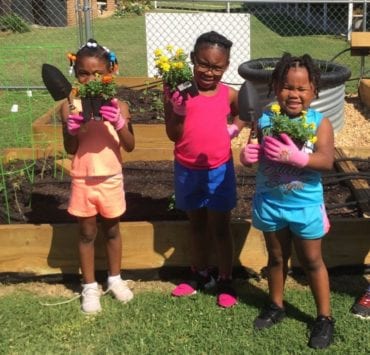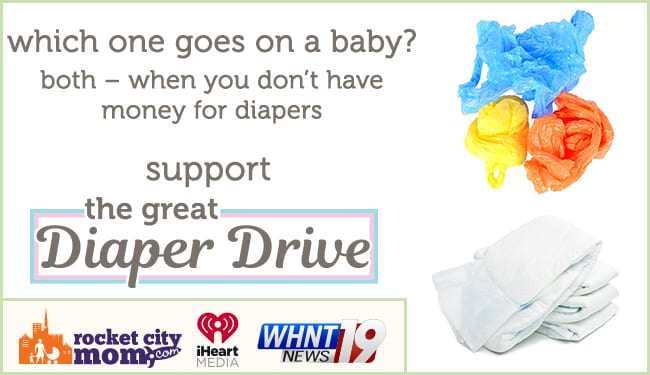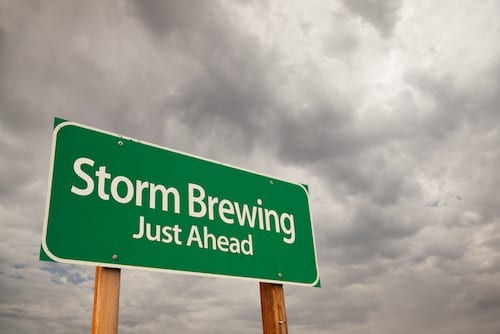Severe Weather Safety for Families in the Tennessee Valley
- Tornado safety tips for kids & families
- What to have in your home severe weather kit
- List of local storm shelters
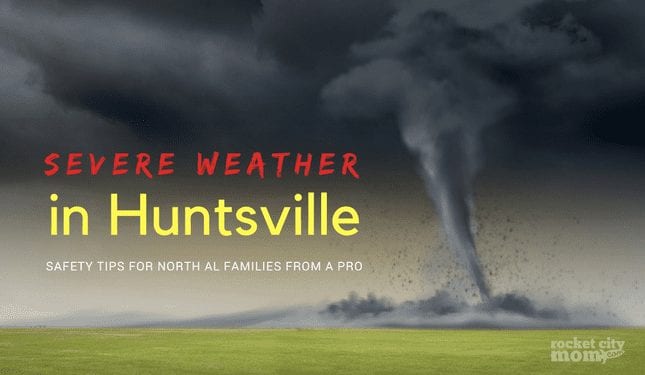
If you’re a parent, Tornado Season might be at the top of your anxiety list. But there are things you can do to be prepared for severe weather, and we’ve enlisted the help of WHNT’s Weather Authority Team to give you some invaluable tips.
It doesn’t matter if you are a North Alabama native or a newcomer, you most likely know about the historic tornado outbreak of April 27, 2011. But newcomers to the Huntsville area likely have many questions about preparing for severe weather and the specific things you can do to stay safe, especially for your kids and families.
The peak of severe weather season in North Alabama happens in early May. In fact, May Fourth is the ‘peak’ of the season according to climatology, but we can have nasty storms at any time of year.
What Makes a Storm ‘Severe’?
High winds, hail and tornadoes make up severe weather in Alabama, and we get a lot of all three in the Spring! Alabama recorded 47 severe weather days in 2017 with over 700 reports of severe weather (wind, hail, and tornadoes combined).
A severe storm produces one or a combination of the following:
- Wind gusts at or above 58 miles per hour
- Quarter-sized hail (1” diameter) or larger
- Tornado(es)
Severe Weather Is More Than Tornadoes
Tornadoes get the highest billing and most recognition in severe storms, but your odds of getting hit by a tornado are much lower than getting a 50-60 mile per hour wind gust, damaging hail, or a deadly lightning strike. On the biggest tornado day in recent history – Alabama’s generational tornado outbreak on April 27, 2011 – only 1% of the total land area of this state got a direct ‘hit’ from a tornado.
Be ready! Anytime a Severe Thunderstorm Warning is issued, plan for strong winds that could knock down trees, knock out the electricity, bring large hail, heavy rain, and of course, dangerous lightning.
How Do You Know When It’s Headed Your Way?
These are must-haves your family needs for staying ahead of severe storms in Alabama.
The Right Radio
A programmable NOAA Weather Radio with SAME code technology (so you can get alerts you choose for the county of your choice). The Midland WR-120 is one of the most reliable, easy-to-program models on the market.
Mobile Alerts
A secondary (mobile/digital) resource like Live Alert 19 that gives you location-specific warnings, lightning alerts, quick access to radar, and hour-by-hour forecasts to help you plan the day
Timely Expert Coverage
Access to local media: find the station you like best and find most trustworthy and stick with them (TV, social, and radio). If you’re traveling, Live Alert 19 allows you to stream live coverage; radio stations like 102.1 WDRM carry WHNT News 19’s coverage if a Tornado Warning is in effect for Madison, Morgan, Limestone, Marshall, Lawrence, Jackson, northern Cullman, eastern Lauderdale, western DeKalb, southern Giles (TN), Franklin (TN), and Lincoln (TN) Counties.
Three Things to Avoid When the Weather Looks Threatening
- Social media posts that show you scary, color-contoured maps that don’t immediately give you any real-world explanation.
- Posts that call for major severe weather many days in advance unless it’s from your trusted source.
- An “It’ll never happen to me” mentality – do not think for one minute that since it’s not happened to you yet that it can’t happen. Be alert, be prepared, and make sure your family knows what to do whatever may come your way.
Creating Your Family’s Severe Weather Plan
Your family should have a plan, or two, or three for different situations – home, church, school, car, etc. Make sure your kids and family members know each scenario. Have a family meeting to discuss it!
Know Your Neighborhood. Getting through nasty storms requires careful thought and planning well before the weather becomes an issue. Before that day comes, know where you live: city, county, neighborhood, nearby landmarks. This is especially important if you are new to the area. You’d be surprised how knowing a little geography can help you make a better decision to protect your family.
Get Warned. Make sure you are ready to receive a warning! NOAA Weather Radio and Live Alert 19 do that for you. And be sure to check those batteries 2-3 times a year.
Know where the safest, sturdiest place in your home is! That’s usually going to be a closet, hallway, or bathroom on the lowest floor near the center of your home. This area should have no windows or outside walls. Here’s more on choosing & prepping your safe place.
Find a Shelter. If you don’t feel safe in your residence, find the nearest public shelter. Some counties offer large shelters available to everyone, including restrained pets; some counties only have shelters run by individual entities. We have a list of known shelters on WHNT.com.
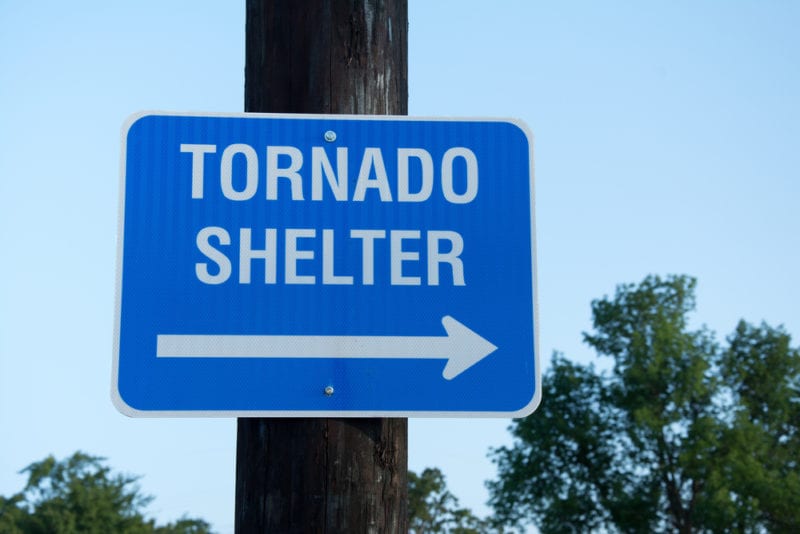
What’s In Your Weather Kit?
This is a box or bag you keep in your ‘safe place’ that has things you will need if a storm damages your home.
- Food: a 3-day supply of non-perishable food for each person in your family
- Water: one gallon of water per person for at least 3 days
- Can openers and utensils
- For kids – Helmets! Bike helmets for kids and something to protect Mom & Dad’s head, too
- For babies – the safest spot for them is in a bucket-style car seat in your safe place
- Weather Radio
- First aid kit
- Blankets/jackets: they keep you warm in the winter, and they protect you from potentially dangerous debris during spring/summer/fall thunderstorms)
- An extra pair of sturdy shoes: in case there’s debris left behind after the storm
- Sanitation items: soap, moist towelettes, hand sanitizer gel
- Flash lights and batteries
- Extra medication: enough for a week; copies of prescriptions
- Pet food, water, health forms, a spare leash, IDs for family dogs, cats, birds, etc.
- Extra food, water, bottles, diapers, etc. for families with infants and young children
- Extra medication, denture care, spare eyeglasses or contact lenses with solution, spare hearing aid batteries for elderly family members
Emergency safety kit for the car:
- Jackets/blankets
- Sturdy shoes or boots
- Water
- Non-Perishable Food
- Portable Phone Charger

Don’t Panic – We’re More Prepared Now Than We Used To Be!
Severe weather prediction and detection is much better now than 20 years ago thanks to radar advancements (like dual-pol radar), a better network of trained storm spotters, and research from institutions like UAH that has revolutionized the way we look at storms and communicate the threat.
The average ‘lead time’ (time from the warning to the tornado occurring) is about 13 minutes. Greater understanding of storms and higher-quality short-range atmospheric modeling may help us push that ‘lead time’ to as much as 30 minutes to one hour in a few years.
That said, when you hear me say to take shelter on the air, take shelter. I’m using all these tools and my extensive knowledge and experience to make that call for you.
When Young Kids Have Storm Anxiety
Severe weather can be scary and traumatizing for your little ones. Let’s be real – even adults get nervous! But there are some easy things you can do to help them.
Calm their fears by showing them how to be safe. Run through your plan on a quiet weather day and review it on days when the weather could get rough.
Give them knowledge! Thunderstorms are part of the natural water cycle; if we didn’t have storms, there wouldn’t be water to drink, food to eat, or a pool to swim in come summertime. Storms can do bad things, but they also help us survive by bringing the rain we need to live.
If your child has severe astraphobia (fear of thunderstorms), take them on a field trip. Come visit us at WHNT News 19. Go visit the National Weather Service. Sometimes a personal touch helps build the trust needed to deal with that fear.
Severe storms can take you by surprise in the summer months: sunny one minute, stormy the next. Be aware of those storms when you’re outdoors at a ball park, pool, or just in the backyard. They can bring very high winds, incredible amounts of lightning, and can be some of the worst weather you’ll experience all year long.
RCM’s Storm Tips for Families
Having lived here her whole life, Rocket City Mom Chief Editor, Stephenie Walker, also has a few severe weather tips for families:
- When meteorologists start predicting storms 24-48 hours in advance, pay attention. That’s a good time to revisit your storm kit, check your batteries, and restock water if needed. It’s also smart to gas up the car and get some cash just in case.
- Invest in a good phone powerbank (or two!) and make sure it’s charged before severe weather comes through.
- Be sure to run your dishwasher and wash any dirty dishes BEFORE severe weather hits. Take it from someone who forgot the dishwasher was dirty when the 2011 tornadoes came through – that smell will knock you over when you don’t have power or water for several days.
- Do not – I repeat – DO NOT wear flip flops or flimsy shoes during a severe weather event. If you think you might have to take shelter in your safe spot, get sturdy shoes ready and on your family’s feet. Picking your way through debris in socks or flip flops is very dangerous.
You Might Also Like…
This article originally published in 2018 and has been updated with current info.
Rocket City Mom is a website about raising children in and around Huntsville, Alabama. Started in late 2010 by a local mom and newcomer to Huntsville, Rocket City Mom has grown into a thriving community of local parents and now boasts a staff of four, thirteen regular contributors, and tens of thousands of Tennessee Valley readers making it the #1 Parenting Resource in North Alabama.




